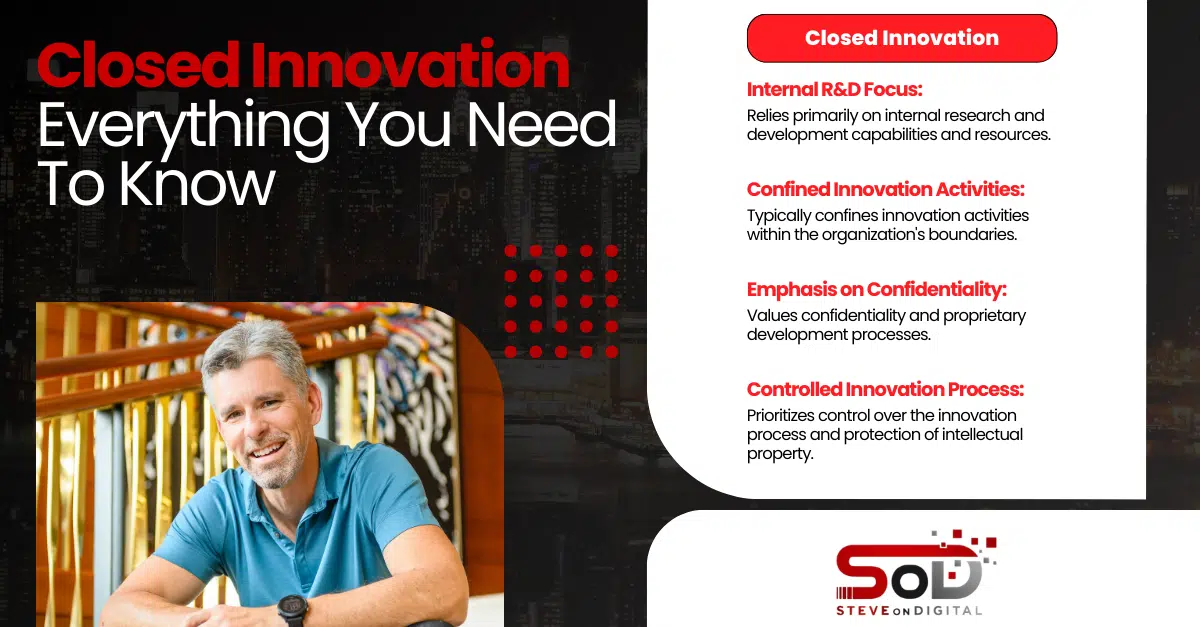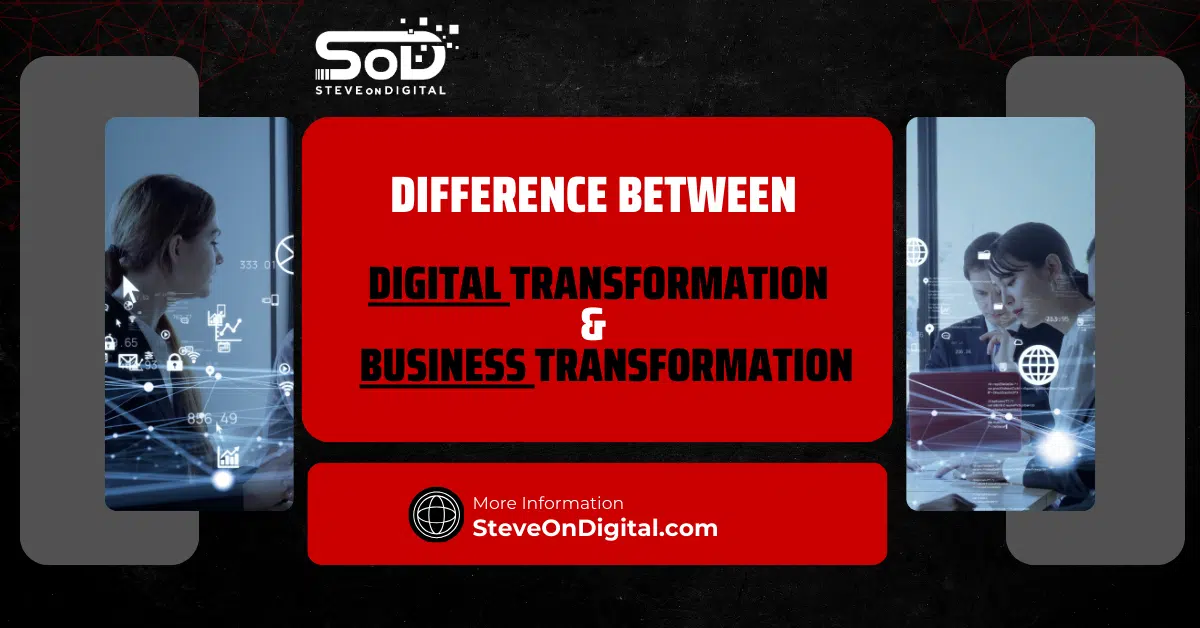Hello there, I’m Steve Johnston from SteveOnDigital, and today we’re diving deep into a topic that’s close to my heart and vital for any business navigating the innovation landscape: “Advantages And Disadvantages Of Closed Innovation.”
As someone who has spent years in the trenches of digital transformation, guiding small and medium-sized businesses through the complexities of the digital era, I’ve witnessed firsthand the pivotal role innovation plays in sustaining and scaling businesses.
Closed innovation refers to the traditional model of innovation where research and development (R&D) activities, from the inception of an idea to its commercialization, are carried out internally within the confines of a company.
This approach relies heavily on the company’s internal resources, knowledge, and capabilities to drive innovation.
Contrastingly, open innovation is a more modern approach that breaks down the walls of the traditional innovation model.
It suggests that companies can and should use external ideas as well as internal ideas, and internal and external paths to market, as they look to advance their technology.
The closed innovation model, epitomized by famous examples like Bell Labs and Xerox PARC, once stood as the hallmark of the innovation process, demonstrating the competitive advantage of leveraging internal resources to develop breakthrough innovations.
Yet, the digital era’s advent has highlighted the limitations of the traditional approach, propelling a shift towards the open innovation model.
This transition not only mirrors a paradigm shift in innovation management and business models but also aligns with the accelerating emergence of new technologies and the global flow of external ideas, urging companies to incorporate external expertise and resources to maintain competitiveness.
Part 1: Advantages Of Closed Innovation
1. Control Over Intellectual Property
One of the cornerstone advantages of the closed innovation model is the unparalleled control it offers over intellectual property (IP).
In today’s fast-paced, highly competitive market, the protection of IP is not just a legal formality; it’s a strategic asset that can provide a significant competitive advantage.
The significance of intellectual property in maintaining competitive advantage cannot be overstated.
It is the lifeblood of innovation, providing companies the legal rights to stop others from copying or unfairly profiting from their innovations.
This is particularly crucial in industries where the development cost of new products is high, but the cost of copying is low.
In such scenarios, robust IP protection ensures that innovators can recoup their investments and encourages continued investment in R&D.
During my time advising businesses on digital strategy, I’ve seen numerous examples of companies leveraging closed innovation to protect their trade secrets and maintain a competitive edge.
A prime example is the pharmaceutical industry, where companies spend billions on drug research and development.
The closed innovation model allows these companies to safeguard their findings, securing patents that grant them exclusive rights to produce and sell the new drugs they develop.
This not only recoups their substantial investment but also funds future research endeavors.
Another example from my personal experience involves a client in the technology sector, who developed a proprietary algorithm that significantly optimized their operational efficiency.
By adopting a closed innovation approach, they were able to keep their breakthrough under wraps, securing a patent before any competitors could develop a similar solution.
This move not only solidified their market position but also created new revenue streams through licensing agreements, illustrating the tangible benefits of controlling intellectual property through closed innovation.
2. Streamlined Innovation Processes
Among the primary advantages of the closed innovation approach is the unparalleled efficiency derived from having an in-house team dedicated solely to the innovation processes.
This arrangement ensures a streamlined pathway through which innovative ideas are cultivated, rigorously tested, and brought to fruition within a controlled ecosystem, epitomizing the essence of the closed innovation model’s strategy to harness internal capabilities and proprietary knowledge for the development of innovative products.
- Efficiency: In closed innovation, the barriers to communication are lower, decision-making is faster, and alignment with the company’s strategic goals is more straightforward. This efficiency stems from the team’s familiarity with the company’s objectives, technologies, and market needs.
- Control: Companies have full control over the entire process, from the generation of new ideas to the development and commercialization of innovative products. This control can lead to faster time-to-market for new products and improvements, an essential factor in industries where speed is of the essence.
- Case Studies: A famous example of successful closed innovation is the development of the Post-it Note by 3M.
This innovation came about through internal experimentation and the company’s willingness to invest in the development of a product that was initially seen as a solution looking for a problem.
The Post-it Note has become a staple in offices around the world, illustrating the potential for internal teams to drive innovation that captures the market.
Another case is Apple Inc., which epitomizes the closed innovation model by developing its products in secrecy to maintain a competitive edge.
The development of the iPhone, for example, revolutionized the smartphone industry and was conducted under strict confidentiality, ensuring that Apple could secure patents and lead the market with its innovative technology.
3. Integration With Internal Capabilities And Resources
The closed innovation model allows for the seamless integration of innovation processes with a company’s existing internal resources and capabilities.
This synergy is particularly beneficial for companies with established infrastructures and a wealth of internal expertise, as it allows for the organic growth of innovative solutions that are closely aligned with the company’s core competencies.
- Leveraging Expertise: By utilizing the knowledge and skills of existing employees, companies can foster an environment of continuous improvement and innovation. This approach capitalizes on the intimate understanding employees have of the company’s products, processes, and challenges.
- Resource Allocation: Closed innovation models enable companies to allocate their resources more strategically, focusing on projects that align with their long-term strategic goals. This targeted allocation of resources can lead to more impactful innovations and a stronger competitive position in the market.
Example:
Lockheed Martin’s Skunk Works is an exemplar of how a company can leverage its established infrastructure for breakthrough innovations.
Skunk Works operates with a high degree of autonomy within Lockheed Martin, yet it closely integrates with the company’s broader resources and capabilities.
This setup has enabled the development of some of the most advanced aerospace technologies, such as the U-2 and SR-71 Blackbird spy planes, demonstrating the power of leveraging internal resources in a closed innovation model.
Part 2: Disadvantages Of Closed Innovation
1. Limited External Input
One significant challenge of the closed innovation model is its inherent limitation on external input.
By focusing solely on internal resources and capabilities, companies may inadvertently insulate themselves from fresh ideas and diverse perspectives that could spur breakthrough innovations.
- Challenges Of Isolation: Operating in a silo can lead to a homogenization of thought, where ideas are recycled without the infusion of new, external perspectives. This isolation can stifle creativity and hinder a company’s ability to innovate effectively.
- Real-world Consequences: Ignoring emerging technologies and external expertise can have dire consequences. Kodak’s failure to adapt to the digital photography revolution is a prime example. Despite having the capabilities to pioneer digital photography, their commitment to the traditional film model ultimately led to their downfall. This showcases the risk of overlooking external innovations and market shifts.
2. Higher Costs And Resources
Closed innovation models often require substantial financial and human resources to maintain.

The onus is on the company to research, develop, test, and market innovations entirely in-house, which can be both costly and resource-intensive.
- Financial Implications: Developing new products or technologies from scratch without leveraging external partnerships or collaborations can significantly increase R&D expenditures. For example, pharmaceutical companies can spend billions on drug development processes, with no guarantee of market success.
- Cost-effectiveness Comparison: Incorporating external ideas and resources, as seen in open innovation models, can mitigate these costs. Crowdsourcing ideas, for instance, can provide access to a larger pool of innovations at a fraction of the cost, demonstrating a more economical approach to innovation.
3. Slower Adaptation To Market Changes
The pace at which markets evolve has accelerated, thanks in part to technological advancements and globalization.
Companies relying on closed innovation models may find themselves at a disadvantage, unable to adapt quickly to these changes.
- Examples Of Failure To Adapt: Blockbuster’s decline in the face of digital streaming services like Netflix underscores the perils of sticking too rigidly to a closed innovation approach. Their inability to pivot and embrace new technologies and business models led to their obsolescence.
- The Need For External Knowledge: In a digital market that changes at lightning speed, access to external knowledge and open innovation can be a lifeline. It allows companies to tap into a global network of ideas and technologies, ensuring they remain relevant and competitive.
Through my work with SMEs, I’ve seen how the allure of maintaining full control over the innovation process can be tempting.
Yet, the digital transformation era demands flexibility, openness, and a willingness to engage with the world beyond our company walls.
The disadvantages of closed innovation—limited external input, higher costs, and slower adaptation to market changes—highlight the need for a more nuanced approach to innovation, one that balances internal capabilities with the boundless potential of external collaboration.
Advantages vs. Disadvantages Of Closed Innovation
| Advantages of Closed Innovation | Disadvantages of Closed Innovation |
| Control over intellectual property | Limited external input |
| Streamlined innovation processes | Higher costs and resources |
| Integration with internal capabilities | Slower adaptation to market changes |
Part 3: Navigating Between Closed And Open Innovation
1. The Hybrid Model: Combining The Best Of Both Worlds
The hybrid innovation model represents a strategic amalgamation of closed and open innovation principles, aiming to harness the control and focus of internal R&D while tapping into the vast pool of external ideas and collaborations.
| Feature | Closed Innovation Model | Open Innovation Model | Hybrid Innovation Model |
| Source of Ideas | Internal | Internal and External | Internal and External |
| IP Management | Strict internal control | Shared or open IP | Strategic combination |
| Collaboration | Limited | Extensive with external partners | Selective and strategic |
| Adaptability | Lower | Higher | Moderate to high |
| Cost | Potentially high | Lower due to shared resources | Managed through strategic partnerships |
This approach acknowledges that no company can afford to rely solely on its internal capabilities nor can it expose itself completely to external influences without safeguarding its competitive edge.
- Introduction To The Hybrid Model: This model facilitates a flexible approach to innovation, where companies maintain core competencies in-house but remain agile enough to incorporate external innovations and collaborations. It’s about finding the right balance between protecting proprietary knowledge and embracing the open exchange of ideas.
- Case Study: Procter & Gamble’s “Connect + Develop” strategy is a pioneering example of the hybrid model in action. By opening up to external ideas while leveraging its internal R&D prowess, P&G has successfully brought to market innovative products that might not have been possible through closed innovation alone. This strategy not only accelerated their innovation process but also expanded their innovation ecosystem exponentially.
2. Strategic Partnerships And Collaboration
A cornerstone of the hybrid model is the strategic use of partnerships and collaborations to enhance innovation.
These relationships allow companies to bridge gaps in their knowledge or capabilities, access new markets, and accelerate development cycles.
- The Role Of External Partners: Collaborations with universities, research institutions, startups, and even competitors can provide fresh perspectives and access to specialized knowledge or technologies. These partnerships often result in mutually beneficial outcomes, driving innovation more efficiently than either party could achieve alone.
- Examples Of Successful Collaborations: The partnership between NASA and SpaceX is a testament to the power of collaboration between established entities and innovative startups. SpaceX’s revolutionary approach to space travel has been accelerated by NASA’s experience, resources, and credibility, illustrating how strategic partnerships can push the boundaries of what’s possible.
3. Intellectual Property Management In A Hybrid Model
Managing intellectual property (IP) is a critical aspect of the hybrid innovation model.
It requires a nuanced strategy that protects the company’s proprietary assets while facilitating the exchange of ideas and technologies with external partners.
- Balancing Protection And Collaboration: Effective IP management in a hybrid model involves clear agreements on the ownership of co-developed innovations, licensing arrangements, and non-disclosure agreements that protect sensitive information without stifling the collaborative spirit.
- Strategies For Managing Intellectual Property: Companies can employ various strategies to manage IP in joint ventures, including creating joint IP ownership structures, licensing agreements, and establishing separate entities to manage co-developed innovations. These strategies ensure that all parties are fairly rewarded for their contributions while safeguarding their competitive advantages.
From my own journey in advising SMEs, I’ve seen the transformative impact of adopting a hybrid innovation approach.
It allows businesses to remain competitive in their core areas while leveraging the agility and fresh ideas that external collaborations bring.
The key is to maintain a strategic balance, ensuring that the drive for openness does not compromise the company’s foundational strengths.
Part 4: Future Of Innovation Models In The Digital Era
In our journey through the advantages and disadvantages of closed innovation, we’ve unpacked a lot, from the intricacies of protecting intellectual property to embracing the vast landscape of open innovation.

I’m Steve Johnston from SteveOnDigital, and I’ve been right there with you, navigating these concepts not just in theory but in the real-world application through my work with SMEs.
As we look toward the future, it’s clear that the digital era is reshaping the innovation landscape in profound ways.
1. The Role Of Digital Transformation In Innovation
Digital transformation transcends being merely a trendy term; it’s a critical driver reshaping the landscape of the innovation model, advocating for a modern approach that integrates digital technology across every business facet.
This transformative era fundamentally alters operational methodologies and the very fabric of how companies generate value, compelling a reevaluation of the innovation process.
It encourages a hybrid innovation model that leverages both internal and external resources, blending the traditional closed innovation approach with the open innovation model to foster the development of innovative solutions that cater to market demands.
- Impact On Collaboration: Digital platforms and tools have democratized access to information and expertise, breaking down the barriers that once confined innovation within the walls of individual companies. Platforms like GitHub for software development or Innocentive for open innovation challenges are prime examples of how digital tools facilitate collaboration across geographical and disciplinary boundaries.
- Acceleration Of Innovation Processes: Digital technologies enable rapid prototyping, data analytics for real-time feedback, and virtual simulation environments, significantly speeding up the innovation process. These tools allow companies to iterate quickly, fail fast, and pivot as necessary, embodying the agile approach that is crucial in today’s fast-paced market.
2. Emerging Technologies And Their Influence
Emerging technologies such as AI, blockchain, IoT (Internet of Things), and quantum computing are not just enhancing existing products and services; they’re enabling entirely new categories of innovation.
Their influence extends across all sectors, from healthcare and finance to manufacturing and education.
- AI And Innovation: AI, in particular, is a game-changer, offering unprecedented capabilities in data analysis, pattern recognition, and decision-making. Its applications in predictive maintenance, personalized healthcare, and automated customer service are just the tip of the iceberg. AI’s role in enhancing innovation processes through tools like automated design software or innovation management platforms is also noteworthy.
- Blockchain For Transparency and Security: Blockchain technology is revolutionizing how we think about data integrity and transaction security, with potential applications in supply chain management, intellectual property rights management, and secure peer-to-peer collaboration.
- Preparing For Future Trends: Companies must stay abreast of these technologies, understanding their potential and integrating them into their innovation strategies. This might involve investing in R&D, partnering with tech startups, or cultivating a culture of continuous learning and adaptability within the organization.
| Emerging Technology | Potential Impact on Innovation |
| Artificial Intelligence (AI) | Enhances data analysis, improves decision-making, and accelerates design processes |
| Blockchain | Increases data integrity, transaction security, and intellectual property management |
| Internet of Things (IoT) | Enables smarter product development and real-time market feedback |
| Quantum Computing | Offers unprecedented computational power for problem-solving in complex systems |
Conclusion
Reflecting on our exploration of closed innovation, it’s evident that while this model offers significant advantages in terms of control and protection, it also presents challenges in a world that’s increasingly open and interconnected.
The limitations of closed innovation—especially in terms of cost, adaptability, and access to external ideas—underscore the need for a more flexible approach.
In the digital era, innovation cannot be confined to the internal resources of a company or the silos of a closed model.
The future of innovation is hybrid, blending the best of closed and open models to create a dynamic, responsive approach that leverages digital transformation and emerging technologies.
For SMEs and businesses of all sizes, the message is clear: Embrace the digital transformation, stay informed about emerging technologies, and consider hybrid models of innovation that balance the protection of intellectual property with the benefits of collaboration and openness.
Innovation is fundamentally about solving real-world problems and improving lives.
By adopting a people-first approach that focuses on creating value, companies can navigate the complexities of the modern innovation landscape with agility and purpose.
As we move forward, let’s keep the conversation going.
I encourage you to share your thoughts, experiences, and questions on innovation in the digital era.
Together, we can navigate these exciting times, harnessing the power of innovation to create a brighter future.




